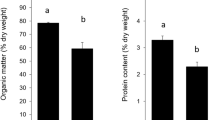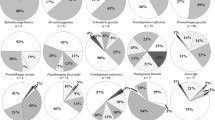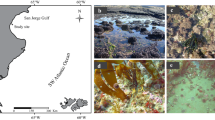Abstract
Preference rankings for 13 macrophytes were established for the subtidal herbivorous snail Lithopoma undosum using two-choice laboratory experiments and consumption rates. L. undosum did not discriminate among three kelp foods (Egregia menziesii, Eisenia arborea and Macrocystis pyrifera) but ate kelp preferentially and more rapidly over all but Ulva spp. among tested macrophytes. Secondary preferences were established for the red alga Pterocladiella capillacea, followed by the coralline Lithothrix aspergillum, whereas the brown seaweeds Zonaria farlowii and Halidrys dioica and the seagrass Phyllospadix torreyi were the least preferred macrophytes. Fastest consumption rates (1.91 g day−1) were measured in trials consisting only of kelp foods. These results indicate that L. undosum exhibits clear feeding preferences even when given less-preferred, non-kelp macrophytes. Using an ash-marker technique, we determined total organic, carbon, and nitrogen assimilation efficiencies (AE%) for six macroalgae used in preference trials. Tested macrophytes were assimilated at different efficiencies but a pattern was not detected between AE (%) and a macrophyte’s position in L. undosum’s preference hierarchy. Highest total organic AEs were found for P. capillacea (61.2%) and H. dioica (59.4%); lowest AEs were detected for E. menziesii (34.9%), a preferred dietary item. Nitrogen was assimilated from red algae with higher efficiencies (74.9–84.3%) than from brown or green algae. These data suggest that the digestive capabilities of L. undosum are better suited for assimilating organic material and nitrogen from less-preferred, non-kelp foods. This supports the hypothesis that factors besides nutritional composition and digestive optimization have played a role in the evolution of feeding preferences in L. undosum and probably other herbivorous snails associated with northeastern Pacific kelp beds.




Similar content being viewed by others
References
Aguilar Rosas R, Torres-Moye G, Almanza Heredia A (1990) Qualitative analysis of the marcoalgae diet of the snail, Astraea undosa Wood 1828, in Punta Banda Baja California, Mexico. Cienc Mar 16:111–120
Alfaro AC, Carpenter RC (1999) Physical and biological processes influencing zonation patterns of a subtidal population of the marine snail, Astraea (Lithopoma) undosa Wood 1828. J Exp Mar Biol Ecol 240:259–283
Arrontes J (1999) On the evolution of interactions between marine mesoherbivores and algae. Bot Mar 42:137–155
Barry JP, Ehret MJ (1993) Diet, food preference, algal availability for fishes and crabs on intertidal reef communities in southern California. Environ Biol Fishes 37:75–95
Best B (1963) Feeding Activities of Tegula funebralis. Veliger 6:42–45
Calow P (1975) The feeding strategies of two freshwater gastropods, Ancylus fluviatilis Mull. and Planorbis contortus Linn. (Pulmonata), in terms of ingestion rates and absorption efficiencies. Oecologia (Berlin) 20:33–49
Carefoot TH (1967) Growth and nutrition of three species of opisthobranch molluscs. Comp Biochem Physiol 21:627–652
Carefoot TH (1970) A comparison of absorption and utilization of food energy in two species of tropical Aplysia. J Exp Mar Biol Ecol 5:47–62
Carefoot TH (1987) Gastropoda. In: Griffiths. C.L.; Griffiths RJ (ed) Animal energetics. Academic, New York, pp 89–173
Cruz-Rivera E, Hay ME (2001) Macroalgal traits and the feeding and fitness of an herbivorous amphipod: the roles of selectivity, mixing, and compensation. Mar Ecol Prog Ser 218:249–266
Duffy JE, Hay ME (1991) Food and shelter as determinants of food choice by an herbivorous marine amphipod. Ecology 72:1286–1298
Duffy JE, Hay ME (1994) Herbivore resistance to seaweed chemical defense: the roles of mobility and predation risk. Ecology 75:1304–1319
Edwards TW, Horn MH (1982) Assimilation efficiency of a temperate-zone intertidal fish (Cebidichthys violaceus) fed diets of macroalgae. Mar Biol 67:247–253
Estes JA, Steinberg PD (1988) Predation, herbivory, and kelp evolution. Paleobiology 14:19–36
Fawcett M (1984) Local and latitudinal variation in predation on a herbivorous marine snail. Ecology 65:1214–1230
Fleming AE (1995a) Digestive efficiency of the Australian abalone Haliotis rubra in relation to growth and feed preference. Aquaculture 134:279–293
Fleming AE (1995b) Growth, intake, feed conversion efficiency and chemosensory preference of the Australian abalone, Haliotis rubra. Aquaculture 132:297–311
Foster MS, Schiel DR (1985) The ecology of giant kelp forests in California: a community profile. US Fish Wildl Serv Biol Rep 85:1–53
Foster GG, Hodgson AN, Balarin M (1999a) Effect of diet on growth rate and reproductive fitness of Turbo sarmaticus (Mollusca: Vestigastropoda: Turbinidae). Mar Biol 134:307–315
Foster GG, Hodgson AN, Boyd CS (1999b) Polysaccharolytic activity of the digestive enzymes of the macroalgal herbivore, Turbo sarmaticus (Mollusca: Vestigastropoda: Turbinidae). Comp Biochem Physiol B 122:47–52
Gotshall DW (1994) Guide to marine invertebrates Alaska to Baja. Sea Challengers, Monterey
Halliday EBB (1991) The natural history and feeding ecology of Astraea undosa in a southern California kelp forest. MS. Marine Science, Santa Cruz
Hay ME, Fenical W (1988) Marine plant-herbivore interactions: The ecology of chemical defense. Ann Rev Ecol Syst 19:111–145
Hay ME, Renaud PE, Fenical W (1988) Large mobile versus small sedentary herbivores and their resistance to seaweed chemical defenses. Oecologia 75:246–252
Hickman CS, McLean JH (1990) Systematic revision and suprageneric classification of Trochacean gastropods no.35 science series. Natural History Museum of Los Angeles County, Los Angeles
Himmelman JH, Carefoot TH (1975) Seasonal changes in calorific value of three Pacific coast seaweeds, and their significance to some marine herbivores. J Exp Mar Biol Ecol 18:139–151
Horn MH, Neighbors MA (1984) Protein and nitrogen assimilation as a factor in predicting the seasonal macroalgal diet of the monkeyface prickleback. Trans Am Fish Soc 113:388–396
Horn MH, Mailhoit KF, Fris MB, McClanahan LL (1995) Growth, consumption, assimilation and excretion in the marine herbivorous fish Cebidichthys violaceus (Girard) fed natural and high protein diets. J Exp Mar Biol Ecol 190:97–108
Jensen KR (1983) Factors affecting feeding selectivity in herbivorous ascoglossa (Mollusca: Opisthobranchia). J Exp Mar Biol Ecol 66:135–148
Kennish R, Williams GA (1997) Feeding preferences of the herbivorous crab Grapsus albonlineatus: the differential influence of algal nutrient content and morphology. Mar Ecol Prog Ser 147:87–95
Kitting CL (1980) Herbivore-plant interactions of individual limpets maintaining a mixed diet of intertidal marine algae. Ecol Monogr 50:527–550
Larson BR, Vadas RL, Keser M (1980) Feeding and nutritional ecology of the sea urchin Strongylocentrotus drobachiensis in Maine, USA. Mar Biol 59:49–62
Leighton DL (1966) Studies of food preference in algivorous invertebrates of southern California kelp beds. Pac Sci XX:104–113
Leighton DL, Boolootian RA (1963) Diet and growth in the black abalone, Haliotis cracherodii. Ecology 44:227–238
Lemire M, Himmelman JH (1996) Relation of food preference to fitness for the green sea urchin, Strongylocentrotus droebachiensis. Mar Biol 127:73–78
Littler MM, Littler DS (1980) The evolution of thallus form and survival strategies in benthic marine macroalgae: field and laboratory tests of a functional form model. Am Nat 116:25–44
Lonhart SI (1996) The vertical distribution and diel migration of Norrisia norrisi on Macrocystis pyrifera at Santa Catalina Island. MA Thesis, California State University, Long Beach
Manly BF (1993) Comments on design and analysis of multiple-choice feeding preference experiments. Oecologia 93:149–152
Manly BFJ (1997) Randomization and Monte Carlo methods in biology. 2nd edn. Chapman and Hall, London
Mattson WJ (1980) Herbivory in relation to plant nitrogen content. Ann Rev Ecol Syst 11:119–161
McBride SC, Lawrence JM, Lawrence AL, Mulligan TJ (1998) The effect of protein concentration in prepared feeds on growth, feeding rate, total organic absorption, and gross assimilation efficiency of the sea urchin Strongylocentrotus franciscanus. J Shellfish Res 17:1563–1570
McLean JH (1978) Marine shells of southern California. Natural History Museum of Los Angeles County, Los Angeles
McShane PE, Gorfine HK, Knuckey IA (1995) Factors influencing food selection in the abalone Haliotis rubra (Mollusca: Gastropoda). J Exp Mar Biol Ecol 176:27–37
Montgomery WL, Gerking SD (1980) Marine macroalgae as foods for fishes: an evaluation of potential food quality. Environ Biol Fishes 5:143–153
Morris RH, Abbott DP, Haderlie EC (1980) Intertidal invertebrates of California. Stanford University Press, Stanford
Myers DJ (1986) Size distribution, movement, and feeding selectivity of subtidal Astraea undosa (Gastropoda: Mollusca) from Santa Catalina Island. MA Thesis, California State University, Fullerton
Nicotri ME (1980) Factors involved in herbivore food preference. J Exp Mar Biol Ecol 42:13–26
Padilla DK (1985) Structural resistance of algae to herbivores, a biomechanical approach. Mar Biol 90:103–109
Paine RT (1971) Energy flow in a natural population of the herbivorous gastropod Tegula funebralis. Limnol Oceanogr 16:86–98
Pavia H, Herman Carr PA (1999) Habitat and feeding preferences of crustacean mesoherbivores inhabiting the brown seaweed Ascophyllum nodosum (L.) Le Jol. and its epiphytic macroalgae. J Exp Mar Biol Ecol 236:15–32
Peterson CH, Renaud PE (1989) Analysis of feeding preference experiments. Oecologia 80:82–86
Pyke GH (1984) Optimal foraging theory: a critical review. Ann Rev Ecol Syst 15:523–575
Schaeffer TN, Carpenter RC (1996) Patterns of predation on the gastropod Astraea undosa at Santa Catalina Island, CA, 24th edn. In: Woodling S, Allen D, Stancyk S, Williams-Howze R, Fell D, Wethey N, Pentcheff G, Chandler A, Decho A, Coull B (eds) Ann. Ben. Ecol. Meeting, p 73
Schmitt RJ (1981) Contrasting anti-predator defenses of sympatric marine gastropods (Family Trochidae). J Exp Mar Biol Ecol 71:257–270
Schmitt RJ, Osenberg CW, Bercovitch MG (1983) Mechanisms and consequences of the shell fouling in the kelp snail, Norrisia norrisi (Sowerby) (Trochidae): indirect effects of octopus drilling. J Exp Mar Biol Ecol 69:267–281
Shepherd SA, Steinberg PD (1992) Food preference of three Australian abalone species with a review of the algal food of abalone. In: Shepherd SA, Tegner MJ, Guzman del Proo SA (eds) Abalone of the world: biology, fisheries and culture. Blackwell Scientific Publications, Oxford, pp 169–199
Speiser B, Rowell-Rahier M (1991) Effects of food availability, nutritional value, and alkaloids on food choice in the generalist herbivore Arianta arbustorum (Gastropoda: Helicidae). Oikos 62:306–318
Stachowicz JJ, Hay M (1999) Reduced mobility is associated with compensatory feeding and increased diet breadth of marine crabs. Mar Ecol Prog Ser 188:169–178
Steinberg PD (1985) Feeding preferences of Tegula funebralis and chemical defenses of marine brown algae. Ecol Monogr 55:333–349
Steinberg PD, van Altena I (1992) Tolerance of marine invertebrate herbivores to brown algal phlorotannins in temperate Australasia. Ecol Monogr 62:189–222
Steneck RS, Watling L (1982) Feeding capabilities and limitation of herbivorous molluscs: a functional group approach. Mar Biol 68:299–319
Stuart MD, Brown MT (1994) Growth and diet of cultivated black-foot abalone, Haliotis iris (Martyn). Aquaculture 127:329–337
Toth GB, Pavia H (2002) Lack of phlorotannin induction in the kelp Laminaria hyperborea in response to grazing by two gastropod herbivores. Mar Biol 140:403–409
Uki N, Sugiura M, Watanabe T (1986) Dietary value of seaweeds occurring on the pacific coast of Tohoku for growth of the abalone Haliotis discus hannai. Bull Jpn Soc Sci Fish 52:257–266
Vadas RL (1977) Preferential feeding: an optimization strategy in sea urchins. Ecol Monogr 47:337–371
Van Alstyne KL, Houser LT (2003) Dimethylsulfide release during macroinvertebrate grazing and its role as an activated chemical defense. Mar Ecol Prog Ser 250:175–181
Van Alstyne KL, McCarthy III JJ, Hustead CL, Duggins DO (1999) Geographic variation in polyphenolics levels of northeastern Pacific kelps and rockweeds. Mar Biol 133:371–379
Wakefield RL, Murray SN (1998) Factors influencing food choice by the seaweed-eating marine snail Norrisia norrisi (Trochidae). Mar Biol 130:631–642
Watanabe JM (1984a) Food preference, food quality and diets of three herbivorous gastropods (Trochidae: Tegula) in a temperate kelp forest habitat. Oecologia 62:47–52
Watanabe JM (1984b) The influence of recruitment, competition, and benthic predation on spatial distributions of three species of kelp forest gastropods (Trochidae: Tegula). Ecology 65:920–936
White TCR (1985) When is a herbivore not a herbivore? Oecologia (Berlin) 67:596–597
Acknowledgements
We would like to acknowledge the assistance of Kelly Boyle, John Boyle, Victor Galvan, Tiffany Luas, Andrea Murray, Nicolle Panos, and other members of the Coastal Marine Ecology Lab at CSUF. We are grateful for the assistance and suggestions provided by Michael Horn and Roger Seapy on earlier drafts of this paper. We would also like to acknowledge the support provided by the Department Association Council and the Department of Biological Science at California State University, Fullerton. The first author also is grateful for support from the US Minerals Management Service and the University of Southern California Sea Grant programs while performing this research. All procedures used in these experiments comply with the current laws of USA.
Author information
Authors and Affiliations
Corresponding author
Additional information
Communicated by P.W. Sammarco, Chauvin
Rights and permissions
About this article
Cite this article
Cox, T.E., Murray, S.N. Feeding preferences and the relationships between food choice and assimilation efficiency in the herbivorous marine snail Lithopoma undosum (Turbinidae). Marine Biology 148, 1295–1306 (2006). https://doi.org/10.1007/s00227-005-0166-3
Received:
Accepted:
Published:
Issue Date:
DOI: https://doi.org/10.1007/s00227-005-0166-3




